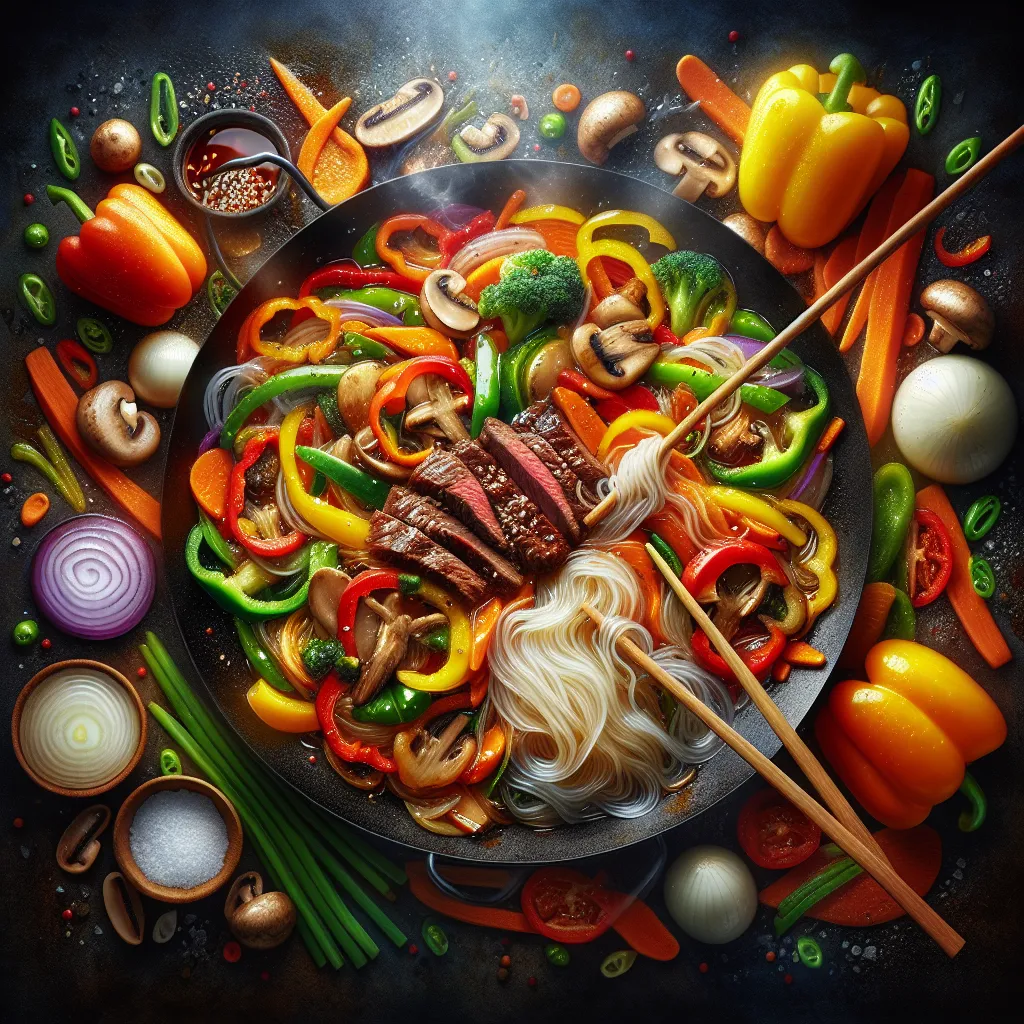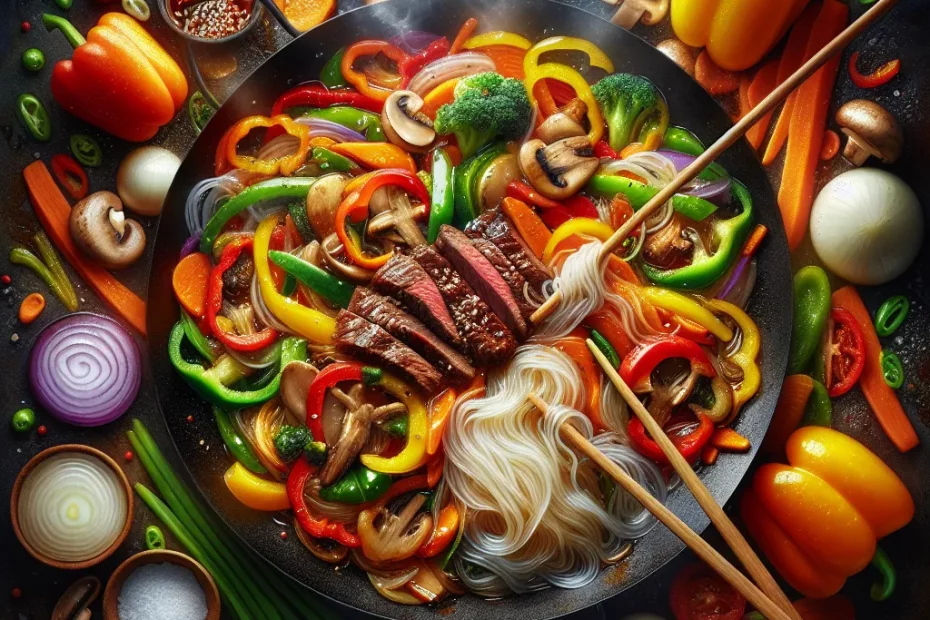Glass noodles stir-fried to perfection with a sweet and savory sauce – that’s the magic of Japchae! Imagine the delightful chewy texture of the noodles combined with a medley of colorful vegetables and tender slices of meat. Originating from Korea, this dish has a rich history and a special place in Korean cuisine. Whether you’re a fan of traditional recipes or enjoy exploring modern twists, Japchae offers a delightful culinary experience that’s sure to please your taste buds. Let’s dive into the world of Japchae and uncover the secrets behind this beloved dish that has captured the hearts of food enthusiasts around the globe. Get ready to embark on a flavorful journey that will leave you craving for more!

Introduction to Japchae
Ah, Japchae – the delightful harmony of sweet and savory flavors dancing on a plate! This traditional Korean dish, also known as Korean glass noodles stir-fry, is a beloved staple in Korean cuisine. Made with delicate glass noodles, an array of colorful vegetables, tender beef, and a luscious soy sauce-based marinade, Japchae is a dish that truly tantalizes the taste buds.
The Star of Japchae: Sweet Potato Starch Noodles
The star of the show in Japchae is the chewy and translucent sweet potato starch noodles, which symbolize longevity and are often served at celebrations and special occasions in Korea. These noodles are not only delicious but also gluten-free, making Japchae a versatile and inclusive dish for many dietary preferences.
Historical Significance of Japchae
One fascinating aspect of Japchae is its historical significance. Originating from the royal court cuisine of the Joseon dynasty, Japchae has a rich culinary heritage that dates back centuries. It was initially served to kings and nobles, showcasing its luxurious and sophisticated roots. Today, Japchae has become a popular everyday dish enjoyed by people of all walks of life.
The Perfect Harmony of Ingredients
What makes Japchae truly special is its medley of ingredients that come together in perfect harmony. The colorful array of vegetables such as bell peppers, carrots, spinach, and shiitake mushrooms not only add vibrant hues to the dish but also provide a variety of textures and flavors. The tender beef slices marinated in a mixture of soy sauce, sesame oil, and sugar add a savory umami depth that complements the sweetness of the noodles.
Flavor Profile of Japchae
When it comes to flavor, Japchae strikes a perfect balance between sweet and savory, with a hint of nuttiness from the sesame oil and a subtle kick of garlic. The soy sauce-based marinade not only infuses the dish with rich umami notes but also adds a glossy sheen to the noodles, making them irresistible to both the eyes and the palate.
Celebrating with Japchae
In Korean culture, sharing a meal is a cherished tradition that brings people together, and Japchae is often enjoyed during festive gatherings and family celebrations. Its colorful presentation and delightful flavors make it a crowd-pleaser that never fails to impress both young and old alike.
Experience Japchae
So, the next time you crave a dish that is both comforting and celebratory, why not whip up a batch of Japchae? Whether you’re a fan of Korean cuisine or just looking to expand your culinary horizons, Japchae is sure to win you over with its irresistible blend of flavors and textures. Get ready to savor each mouthful of this delectable stir-fried glass noodle dish and embark on a culinary journey to the heart of Korean tradition!
Origin and History of Japchae
Ah, Japchae, the delightful dish that never fails to tantalize our taste buds with its sweet and savory flavors! But have you ever wondered about the origin and history of this beloved Korean dish? Let’s dive into the fascinating story behind Japchae.
Origin Story
Japchae, also known as “chapchae,” traces its roots back to the Joseon Dynasty in Korea. Initially, it was a royal court dish, reserved for special occasions and ceremonies due to its luxurious ingredients.
Ingredients
The key component of Japchae is the chewy and translucent glass noodles made from sweet potato starch. These noodles symbolize longevity and are often served at birthdays and celebrations. The dish also features an array of colorful vegetables like carrots, spinach, and mushrooms, along with thinly sliced beef or pork.
Historical Significance
Japchae’s history is intertwined with Korean culture and traditions. It reflects the importance of balance in Korean cuisine, combining various ingredients to create a harmonious and flavorful dish. Over the years, Japchae has evolved to include different ingredients and variations, making it a versatile and popular choice among food enthusiasts.
Celebratory Dish
In modern times, Japchae continues to be a staple at festive gatherings and family celebrations. Its vibrant colors and rich flavors make it a favorite dish for sharing and enjoying together with loved ones.
Health Benefits
Beyond its delicious taste, Japchae offers nutritional benefits as well. Packed with vegetables and lean proteins, it provides a wholesome meal that is both satisfying and nourishing. The balance of ingredients in Japchae makes it a well-rounded dish that caters to both taste and health.
Culinary Evolution
As Korean cuisine gains popularity worldwide, Japchae has also made its mark on the global culinary scene. With chefs putting their own spin on the classic dish and incorporating local ingredients, Japchae continues to evolve while staying true to its traditional roots.
So, the next time you savor a plate of Japchae, remember the rich history and cultural significance behind this delectable dish. Let each bite take you on a journey through time, celebrating the flavors and traditions that make Japchae a beloved culinary treasure!
Key Ingredients in Japchae
Let’s dive into the heart and soul of Japchae, the beloved Korean dish that never fails to tantalize taste buds and warm hearts. The key to creating the perfect Japchae lies in the careful selection and preparation of its essential ingredients. From the chewy glass noodles to the vibrant array of vegetables, each component plays a crucial role in bringing together the sweet and savory flavors that make Japchae so irresistible.
The Star: Glass Noodles
First and foremost, we have the star of the show – the glass noodles. Made from sweet potato starch, these translucent noodles are not only pleasing to the eye but also provide a delightful chewy texture that contrasts perfectly with the tender vegetables. The noodles are soaked, boiled, and then stir-fried to absorb all the wonderful flavors of the dish, making them the foundation on which the rest of the ingredients can shine.
Colorful Vegetables Medley
Next up, we have an assortment of colorful vegetables that add both flavor and visual appeal to Japchae. Thinly sliced carrots, earthy shiitake mushrooms, crisp bell peppers, and delicate spinach come together in a harmonious medley of textures and tastes. The vegetables are quickly stir-fried to retain their freshness and crunch, ensuring that each bite bursts with a burst of freshness and vibrancy.
Savory-Sweet Beef
To elevate the dish to the next level, Japchae also includes thinly sliced beef, marinated in a mixture of soy sauce, sesame oil, and sugar. This savory-sweet beef adds a depth of flavor and richness to the dish, complementing the lightness of the noodles and vegetables perfectly. The beef is seared to perfection, locking in its juices and creating a mouthwatering contrast to the other components.
Flavorful Sauce
Last but certainly not least, the sauce ties everything together in a symphony of flavors. A blend of soy sauce, sesame oil, sugar, and garlic, the sauce infuses every bite of Japchae with a savory umami kick and a hint of sweetness. It coats each ingredient with a glossy sheen, enhancing the overall lusciousness of the dish and leaving you craving for more.
In conclusion, the key ingredients in Japchae work in harmony to create a dish that is not only delicious but also a feast for the senses. From the chewy noodles to the vibrant vegetables, the savory beef, and the flavorful sauce, each component plays a vital role in making Japchae a beloved classic in Korean cuisine. So, the next time you savor a plate of Japchae, remember to appreciate the intricate dance of flavors and textures that make it truly special! 🍜🥕🥩🌶️
Traditional versus Modern Variations
Ah, Japchae – the delightful Korean dish that never fails to tantalize the taste buds with its harmonious blend of sweet and savory flavors. As we delve into the world of Japchae, we come across the intriguing debate between traditional recipes and modern variations that add a creative twist to this classic dish. Let’s take a closer look at how Japchae has evolved over time, from its humble beginnings to the innovative renditions that grace our tables today! 🍜✨
Traditional Japchae
In the traditional realm of Japchae, the emphasis is placed on using authentic ingredients such as sweet potato glass noodles, soy sauce, sesame oil, and an array of colorful vegetables like spinach, carrots, and mushrooms. The cooking process involves stir-frying each component separately before combining them to create a symphony of flavors and textures. This time-honored method ensures that each ingredient retains its unique taste, resulting in a dish that is rich in tradition and flavor. 🌿🥕
Modern Variations of Japchae
On the other hand, modern variations of Japchae have taken the culinary world by storm, with chefs and home cooks alike experimenting with new ingredients and techniques to put a contemporary spin on this beloved dish. From adding protein sources like beef, chicken, or tofu to incorporating fusion elements like truffle oil or exotic spices, the possibilities are endless when it comes to reinventing Japchae. These modern twists breathe new life into the dish, appealing to a wider audience and reflecting the ever-changing landscape of food trends. 🌟🍳
While traditional Japchae remains a timeless classic that pays homage to Korea’s culinary heritage, modern variations inject a sense of innovation and creativity into the mix, catering to evolving palates and preferences. Whether you prefer the comforting familiarity of a traditional Japchae recipe or the excitement of trying out a modern interpretation, one thing is for sure – Japchae will always hold a special place in our hearts and on our dining tables. So why not savor the best of both worlds and enjoy a plate of traditional Japchae alongside a modern twist for a truly unforgettable dining experience? Bon appétit! 🌺🍽️
In conclusion, Japchae is a delightful dish that perfectly balances sweet and savory flavors, making it a beloved Korean classic. Whether you prefer the traditional recipe or enjoy exploring modern variations, the key to a delicious Japchae lies in the quality of ingredients and the care put into its preparation. So next time you’re craving a satisfying and flavorful meal, consider whipping up a batch of Japchae to savor the unique taste of stir-fried glass noodles. Happy cooking!
